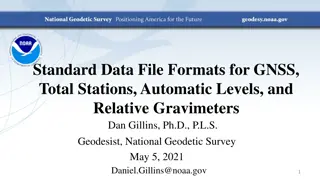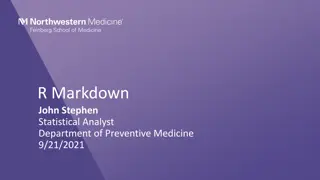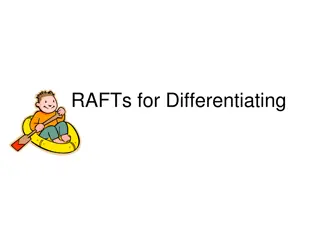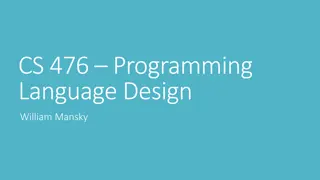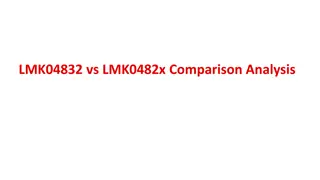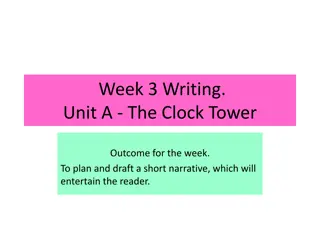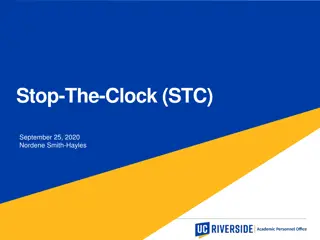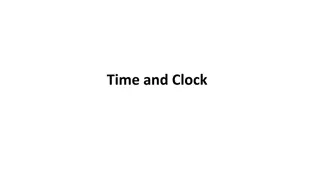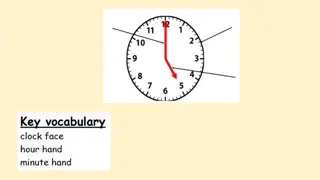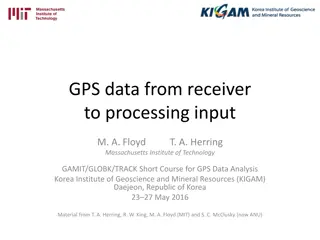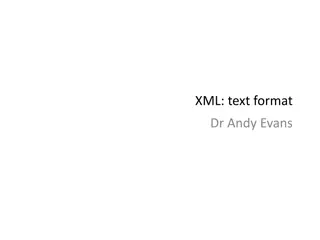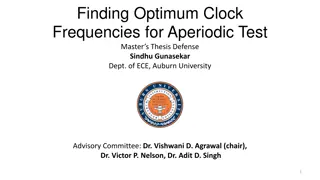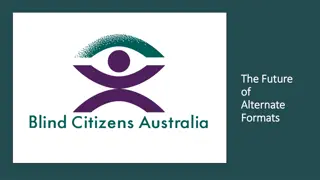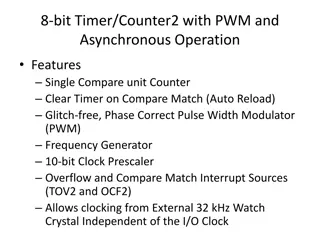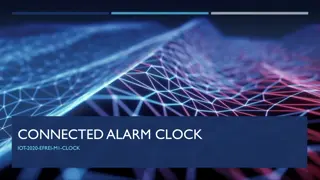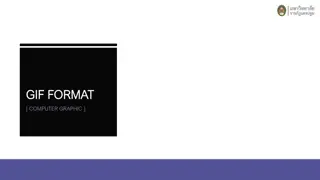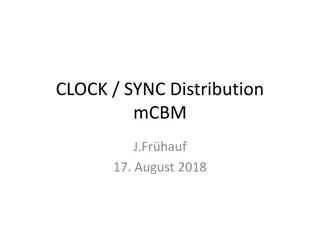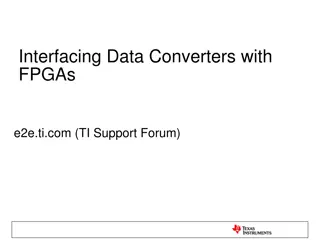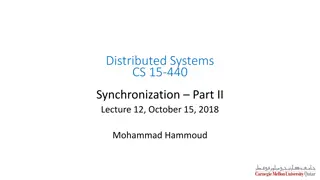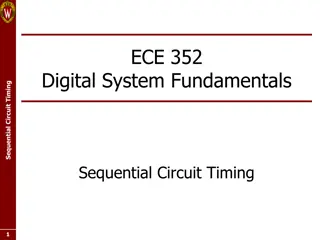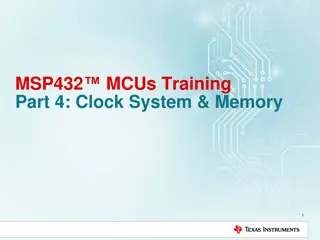Understanding Cardiac Output and Venous Return in Cardiovascular Physiology
Cardiac output, stroke volume, end-diastolic and end-systolic volumes play vital roles in cardiovascular function. Factors affecting cardiac output include physiological conditions and pathological states like hyperthyroidism and myocardial infarction. Venous return, controlled by mechanisms like Fr
0 views • 27 slides
Standard Data File Formats for Geospatial Instruments
Understanding the importance of standard file formats for GNSS, total stations, automatic levels, and relative gravimeters to facilitate data exchange, processing, and preservation in the geospatial industry. Exploring the significance of RINEX and other XML-based formats, along with examples and th
2 views • 30 slides
Understanding Referral to Treatment (RTT) Quality Standards
Referral to Treatment (RTT) Quality Standards, also known as RTT 18 Weeks, is a vital component of the NHS Constitution that guarantees patients a legal right to timely diagnosis and treatment within 18 weeks of referral. It encompasses various stages in a healthcare pathway, each assigned an RTT co
1 views • 12 slides
Understanding R Markdown: A Comprehensive Guide to Statistical Analysis
R Markdown is a powerful tool for statistical analysis, allowing you to create documents that combine text, code, and output in a seamless manner. This guide covers the basics of R Markdown, including its uses, process, sections, creating new files, interactive running of code, document knitting, ou
0 views • 24 slides
Understanding Counters in Sequential Circuits
Counters in sequential circuits are crucial components used for counting clock cycles and measuring time intervals. They are composed of flip-flops that progress through a sequence of states based on clock pulses. This sequential circuit has no inputs other than the clock pulse and relies on its int
1 views • 22 slides
Understanding Sequential Counters in Digital Circuits
Sequential counters, comprised of flip-flops, are essential in digital circuits for counting clock cycles. They advance through states based on clock pulses and can measure time intervals. The circuit's output state solely depends on its present state, with transitions occurring at each clock pulse.
0 views • 22 slides
Understanding Machines: Work, Forces, and Efficiency
Machines play a vital role in making work easier by increasing force, distance, or changing the direction of applied force. Different types of machines like levers, pulleys, and inclined planes simplify work processes. Understanding input and output forces, as well as input and output work, is essen
1 views • 10 slides
Differentiated RAFT Strategies for Engaging Writing Across the Curriculum
RAFTs, an engaging high-level strategy, encourage students to assume roles, consider audiences, write in specific formats, and explore topics. This method motivates students by offering choice and aligning with their interests and learning profiles. Differentiating RAFTs by readiness involves assign
0 views • 15 slides
Understanding Input and Output in Programming: A Comprehensive Guide
This content provides detailed explanations and examples on input and output handling in programming, focusing on concepts such as I/O as State, typed output, and consuming input lists. It covers topics like using print statements, scanning inputs, and building output lists in programming languages.
0 views • 44 slides
Example of COI Disclosure Formats in Academic Presentations
These images provide examples of Conflict of Interest (COI) disclosure formats for oral and poster presentations in academic settings. They outline how authors can disclose any potential COIs in relation to their work over the past three years, including details on employment, stock ownership, paten
1 views • 4 slides
Comparison Analysis of LMK04832 vs LMK0482x
General specifications comparison between LMK04832, LMK04828, LMK04821, and LMK04826 including parameters like VCO frequency range, maximum output frequency, input frequencies, PLL specifications, supply voltage, operating temperature, and output formats. Clock output formats, dividers, and delays d
0 views • 5 slides
The Enigmatic Clock Tower
In a captivating narrative inspired by The Clock Tower, a mysterious girl in a red dress alters reality by manipulating time through a magical clock tower window. As she embarks on a journey to restore the grey world outside, unexpected twists and deep realizations unfold, leaving readers spellbound
0 views • 16 slides
Understanding Stop-The-Clock (STC) Policy in Academic Personnel Offices
The Stop-The-Clock (STC) policy allows assistant-level academic appointees to extend their evaluation period for Associate Professor appointments. It also provides for additional time off the clock for significant life events like childbirth or serious health conditions. Learn about eligibility, pro
0 views • 8 slides
Determining OBS Clock Drift Using Seismic Interferometry
Determining clock errors in Ocean Bottom Seismometers (OBSs) is crucial for accurate seismic data recording. This study presents a method using ambient seismic noise and seismic interferometry to correct clock drift in OBSs. The program developed employs Python/Fortran to analyze seismic data direct
0 views • 10 slides
Understanding Input and Output Limitations in Op Amps
Explore the various input and output limitations in TI Precision Labs Op Amps as presented by Ian Williams and prepared by Art Kay and Ian Williams. Delve into common mode voltage, voltage swing, data sheet parameters translation, input and output stages, examples of common mode voltage, and potenti
0 views • 15 slides
Understanding Time, Clock Synchronization, and Atomic Clocks
Delve into the intricacies of time and clock synchronization, from the rotation of the Earth to atomic clock standards. Explore the importance of physical clock synchronization and the practical implications on technologies like GPS. Uncover the terminology and methodologies involved in achieving pr
0 views • 24 slides
Low-Latency Inter-Datacenter State Machine Replication Using Clock-RSM
Clock-RSM introduces a low-latency approach to inter-datacenter state machine replication by utilizing loosely synchronized physical clocks. This method ensures strong consistency, fault tolerance, and fast failover in a geo-replication environment. By overlapping ordering and replication using phys
0 views • 29 slides
Fun with Calendars and Clocks
Explore the world of calendars and clocks with activities, questions, and fascinating facts. From learning the number of days in different months to understanding how the hands of a clock work, dive into the concepts of time and organization. Engage in interactive tasks like marking birthdays, natio
0 views • 25 slides
Understanding Clock Hands Position at Different Times
Explore how the minute hand points to specific positions on a clock face at different times such as "at o'clock" and "at half past." Visual representations provide a clear understanding of these concepts.
0 views • 6 slides
Understanding Time Through Clocks
Explore the significance of knowing the time, discover the numbers on a clock, compare different clock drawings, learn how to read time using clock hands, identify various clock times, and understand activities associated with specific clock times.
0 views • 13 slides
Enhancing Time-telling Skills with Clock Faces and Hands
Explore activities for teaching time-telling to children using clock faces and hands at o'clock, half-past, quarter-past, and quarter-to times. Engage in vocabulary building, key questions, fluency exercises, and reasoning/problem-solving tasks to enhance understanding and mastery of telling time.
0 views • 54 slides
IEEE 802.11-18-1269-00-00az Clock Synchronization Investigation
In July 2018, a document was presented by Feng Jiang et al. from Intel Corporation focusing on clock synchronization between ISTA and RSTA in IEEE 802.11-18-1269-00-00az standard. The document delves into the impact of sampling clock errors on range estimation, carrier frequency synchronization in 1
0 views • 10 slides
What's the Time, Mr. Wolf? - Fun Clock Times for Kids
Enjoy a playful journey through the clock times with Mr. Wolf in this interactive educational content. Explore different clock times such as 3 o'clock, 5 o'clock, 9 o'clock, 6 o'clock, 12 o'clock, 8 o'clock, 1 o'clock, 11 o'clock, and more. Engage in a visual quiz to identify which clock corresponds
0 views • 15 slides
Understanding GPS Data Processing and RINEX Formats
Learn about the process of transferring GPS data from receivers to processing input, the importance of RINEX formats for universal data exchange, different raw data formats, motivation behind RINEX development, and details about RINEX versions. Explore RINEX 2 data format, its file naming convention
0 views • 13 slides
Evolution of Data Formats in Information Technology
Over time, as data space became more affordable, there has been a shift towards text-based data formats in information technology. This evolution has led to a transition from binary formats to text, making data more understandable for both humans and coders. The move to open data formats, based on i
0 views • 19 slides
Finding Optimum Clock Frequencies for Aperiodic Test
Finding the best clock frequencies for aperiodic testing in integrated circuits is crucial for reducing test time and costs. This study by Sindhu Gunasekar explores the use of aperiodic clock testing to optimize test cycles and minimize power dissipation, ultimately improving testing efficiency.
0 views • 29 slides
Evolution of Formats: Past, Present, and Future
Explore the transition of formats from cassette tapes to digital media, with insights on format preferences from 1997 to 2022. Learn about the changing landscape of alternate formats and the digital future. Contact Sally Aurisch, the CEO of Blind Citizens Australia, for more information.
0 views • 6 slides
8-bit Timer/Counter2 with PWM and Asynchronous Operation
The 8-bit Timer/Counter2 with PWM and Asynchronous Operation features single compare unit, glitch-free operation, phase-correct PWM, frequency generator, clock prescaler, interrupt sources, and external clocking options. It includes registers for control, counter, output compare, asynchronous status
0 views • 14 slides
Introducing Connected Alarm Clock IoT Project
Explore the innovative Connected Alarm Clock IoT project developed by EFREI-M1-CLOCK students. This project combines traditional alarm clock features with IoT technology, allowing users to set unlimited alarms remotely. The system includes equipment such as RTC DS3231, Arduino UNO, Wi-Fi Rev2, and o
0 views • 7 slides
Understanding GIF and file formats in computer graphics
GIF and file formats play a crucial role in computer graphics, defining the structure of images and animations. GIF files consist of a logical screen populated with images or frames, while file formats are divided into segments containing images, extension blocks, and trailers. Extension blocks in G
0 views • 6 slides
Clock Synchronization Distribution For Data Taking Systems
The content details the clock synchronization distribution system for data taking systems requiring specific clock frequencies for various subsystems to ensure synchronous data processing. It covers the setup, external clock relationships, and generation specifics involving different clock frequenci
0 views • 10 slides
FPGA Data Converter Interfacing Overview
Explore various I/O formats for interfacing data converters with FPGAs, including ADC parallel and serial formats like CMOS, LVDS, DDR. Learn about clock edge alignment, parallel, and true serial formats. Understand the differences between SDR and DDR, as well as considerations for clocking and data
0 views • 32 slides
Debate Formats Explained: CX vs. LD
Explore the world of debate with an overview of the CX (Cross-Examination) and LD (Lincoln-Douglas) formats. CX involves policy debates with teams advocating for and against resolutions related to US federal government policies, while LD focuses on one-on-one debates on values and philosophy. Discov
0 views • 11 slides
Understanding Distributed System Synchronization and Logical Clocks
Continuing from the previous lecture on time synchronization, this session delved into logical clock synchronization, mutual exclusion, and election algorithms in distributed systems. Logical clocks, such as Lamport's Clock and Vector Clock, play a crucial role in defining the order of events withou
0 views • 33 slides
Understanding Sequential Circuit Timing and Clock Frequency
Sequential circuit timing is crucial for designing digital systems. The minimum clock period, slack values, clock frequency, and critical paths play key roles in determining the operational speed and performance of sequential circuits. By analyzing flip-flop timing parameters, combinatorial logic de
0 views • 20 slides
General Architecture of Kookmin University's Image Sensor Communication Proposal
Kookmin University submitted a proposal to the IEEE P802.15 Working Group for Wireless Personal Area Networks, focusing on the PHY and MAC layers for image sensor communication. The document outlines design principles, specifications, frame formats, and considerations for both layers. Definitions re
0 views • 41 slides
Guide to Using a Digital Clock for Timekeeping
Learn how to set up and operate a digital clock for timekeeping purposes. This guide covers turning on the clock, setting the main clock, using basic clock functions, managing penalties, recording scores and goals, and utilizing the time-out feature. Familiarize yourself with the menu options and es
0 views • 8 slides
Understanding Clock System, Memory Features, and Flash Operations in MSP432 MCUs
The MSP432 part 4 training covers the clock system's flexibility, offering a wide range of clock sources for high-speed and low-power operations. It highlights high-accuracy, tunable DCO with various frequency ranges and their calibration. Additionally, it discusses memory features such as flash siz
0 views • 9 slides
Understanding File Input/Output (I/O) in C++
File Input/Output (I/O) is an essential concept in C++ programming, allowing for interaction with files stored on secondary storage devices. This involves steps like including the fstream header file, declaring file stream variables, associating them with input/output sources, opening the file, perf
0 views • 19 slides
Stylish Resin Wall Clock
Add a contemporary flair to your decor with a resin wall clock. Available in vibrant colors and artistic designs, it\u2019s perfect for modern interiors. Lightweight and versatile, this clock enhances any room with its unique style and functionality.
0 views • 1 slides

